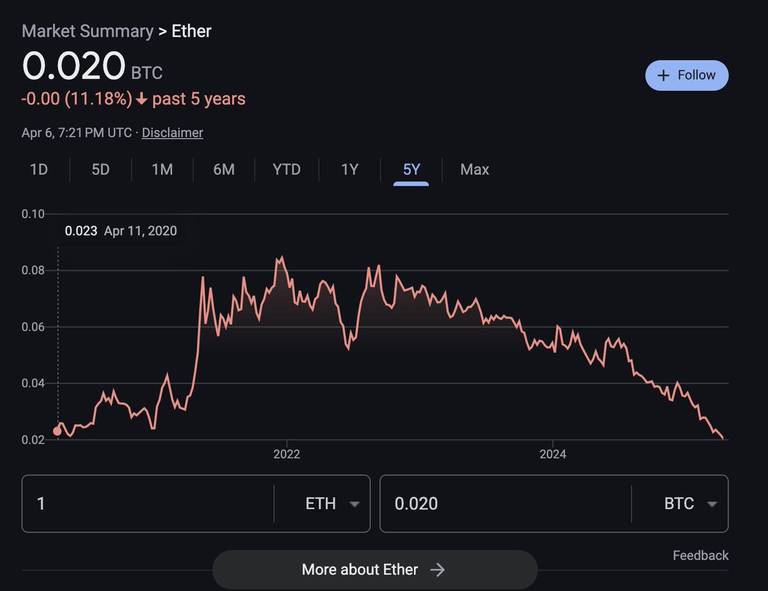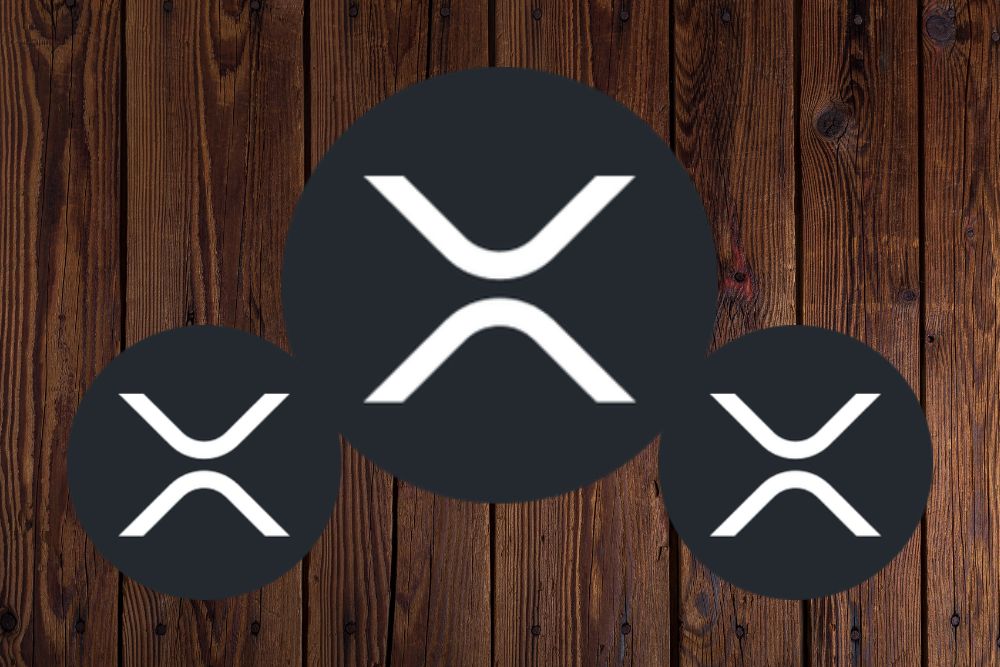
A huge new survey finds 55 million U.S. adults own cryptocurrency, with 76% reporting life improvements and over half eyeing it for long-term financial security. Massive US Survey Reveals 55 Million Crypto Holders—and Their Bold Vision for the Future The National Cryptocurrency Association unveiled findings this week from its most extensive research yet on U.S.
Bitcoin.com
You can visit the page to read the article.
Source: Bitcoin.com
Disclaimer: The opinion expressed here is not investment advice – it is provided for informational purposes only. It does not necessarily reflect the opinion of BitMaden. Every investment and all trading involves risk, so you should always perform your own research prior to making decisions. We do not recommend investing money you cannot afford to lose.
ETH/BTC Ratio Hits Lowest Level Since March 2020 at 0.02113, Now 49 ETH for 1 Bitcoin

The ETH/BTC trading pair has reached its lowest level since March 2020, with the ratio falling to 0.02113 early on April 6, 2025. This represents a decline of over 40% year-to-date. The latest data indicates that it now takes 49 ETH to purchase one Bitcoin, marking a new five-year low for the pair. The ongoing decline reflects a multi-year trend in the cryptocurrency market. This is an AI-generated article powered by DeepNewz, curated by The Defiant. For more information, including article sources, visit DeepNewz . To continue reading this as well as other DeFi and Web3 news, visit us at thedefiant.io Bitcoin.com

Ethereum’s Ecosystem Expands, But $ETH Struggles to Keep Pace: What’s Driving the Disconnect?
While Ethereum’s ecosystem is steadily growing, with great achievements in the burgeoning sectors of stablecoins and tokenized assets, its native asset, $ETH, has failed to keep pace with that growth. Instead, $ETH has languished and even dropped recently, with some crypto watchers suggesting it has hit a five-year low against Bitcoin when it comes to that asset’s trading ratio. Why is Ethereum’s ecosystem somehow expanding at the same time its core asset seems to be suffering? The latest “State of the Network” report from the crypto research firm CoinMetrics dives into this somewhat ironic situation. Ethereum’s Growth: Stablecoins, Tokenized Treasuries, and Layer 2 Developments The fundamentals of Ethereum are strong, and the network continues to set new and impressive records. The supply of stablecoins on Ethereum, for instance, recently hit a record high of around $130 billion. This stablecoin supply is a direct usage metric for Ethereum’s infrastructure, and it reinforces the narrative that Ethereum’s infrastructure is being widely adopted and trusted. It is also a reminder that, while the SEC is trying to delegitimize the way Ethereum has been governed and the way it has been upgraded, there are real, growing, and serious usage applications being built on top of Ethereum’s infrastructure. Besides stablecoins, Ethereum has witnessed substantial growth in tokenized assets. Tokenized assets such as BUIDL’s treasury above $1.8 billion are prime examples. Were it not for Ethereum, this development would be even too low-profile to mention. But given that the financial institution behind tokenized treasury BUIDL has recognized Ethereum as a secure platform for management and storage of its assets, employing Ethereum for such has to be deemed a potential game-changer. Ethereum’s growth has also seen major attention focused on Layer 2 (L2) solutions. These are the direct response to the need to scale up the network while minimizing the burden on Ethereum’s base layer (L1). The L2s have been thriving. They are still retaining huge margins—90% or more—and offering something that, for a long time, seemed unbacked: enhanced scalability with lower transaction costs. But this success is coming at a price for L1, which is main Ethereum network: the fees paid to the Ethereum base layer have dropped significantly. Why is $ETH underperforming while Ethereum’s ecosystem expands? In Q1 2025, Ethereum hit new highs in stablecoins and tokenized assets – yet $ETH fell to a five-year low vs. $BTC . The latest @CoinMetrics State of the Network unpacks the growing disconnect between Ethereum’s… pic.twitter.com/gWexEh9DLu — CoinMetrics.io (@coinmetrics) April 4, 2025 The Disconnect: Why $ETH Is Struggling Even with these positive events, in recent months $ETH has greatly underperformed, particularly compared with Bitcoin. The $ETH/$BTC ratio slipped to a five-year low just recently, which happens to be a pretty good indicator of how well Ethereum is performing relative to Bitcoin. (The lower the ratio, the worse Ethereum is doing.) This trend has some critics hollering that Ethereum is losing its edge over Bitcoin and is somehow becoming less valuable even as the Ethereum network itself is hosting an ever-growing list of assets. One big reason for this disconnect is the dropping revenue from the Ethereum network. The recent decrease in the fees from the Ethereum base layer has affected the demand for $ETH as a utility token. Ethereum’s Layer 2 solutions are now doing way more of the network’s work, meaning Ethereum’s native asset isn’t being used as much anymore, resulting in lower demand for $ETH. And without demand, there isn’t going to be much of a case for $ETH’s value beyond being a store of value. Compounding this issue is the evaporating rate of $ETH burn, which has dropped to about 70 ETH each day. This situation is now is turning Ethereum into an inflationary asset, with an inflation rate of 0.79% that seems to be going up. Long-term holders should be worried. The speed with which the price of $ETH can go up is governed by the amount of demand for the asset. If the supply is increasing at a rate faster than the demand is, well—goodbye, price. Looking Ahead: Ethereum’s Scaling Roadmap and Future Outlook In the face of short-term challenges, Ethereum’s strategy for long-term scaling remains on course. The imminent Pectra and Fusaka upgrades, which form part of Ethereum’s broad roadmap, are anticipated to tackle some of the present problems by not only augmenting blob capacity but also by driving demand for Layer 1 services. The very aim of these upgrades is to restore value accrual to $ETH by raising transaction throughput and pushing network efficiency to new heights. The Pectra upgrade, which is concentrated on enlarging blob capacity, is projected to alleviate congestion on the Ethereum network and make for a speedier, cheaper transaction experience. Fusaka, another critical upgrade, will push various enhancements to Ethereum’s consensus mechanism and allow for even more scalability of the network. These two upgrades taken together should result in an uptick of use of the Ethereum base layer. Although $ETH’s present performance is under par, Ethereum’s future seems bright. With big developments coming up, an ever-expanding ecosystem, and relentless innovation, both on Layer 1 and Layer 2, Ethereum is well set to bounce back from its recent woes. Investors, however, will need to channel their inner Job and be patient; the scaling and other necessary improvements are fairly afoot but will take time to translate into any real benefits for $ETH holders. Disclosure: This is not trading or investment advice. Always do your research before buying any cryptocurrency or investing in any services. Follow us on Twitter @nulltxnews to stay updated with the latest Crypto, NFT, AI, Cybersecurity, Distributed Computing, and Metaverse news ! Bitcoin.com











